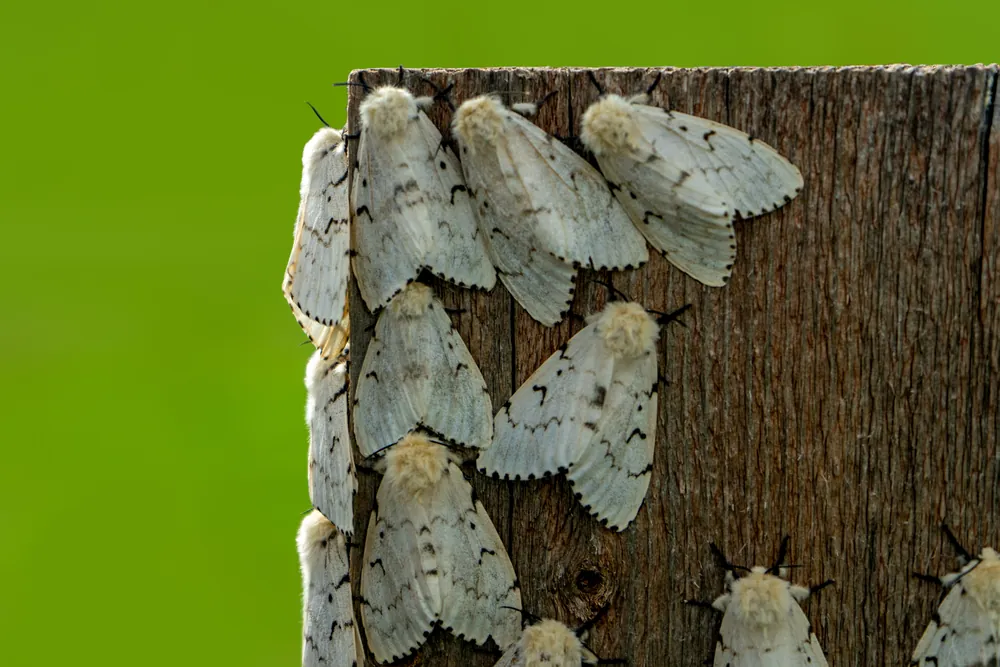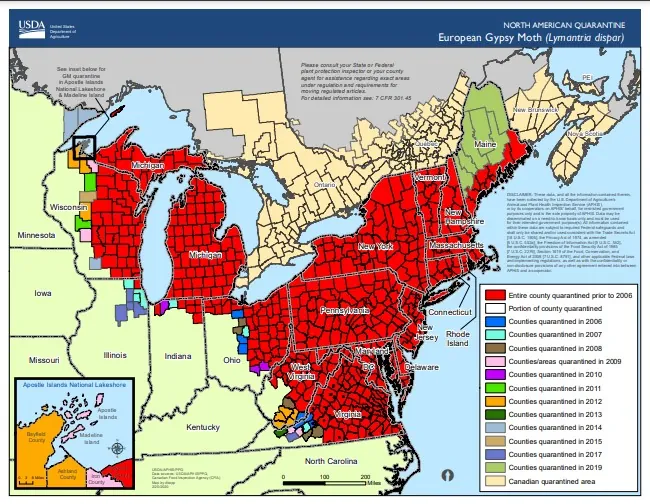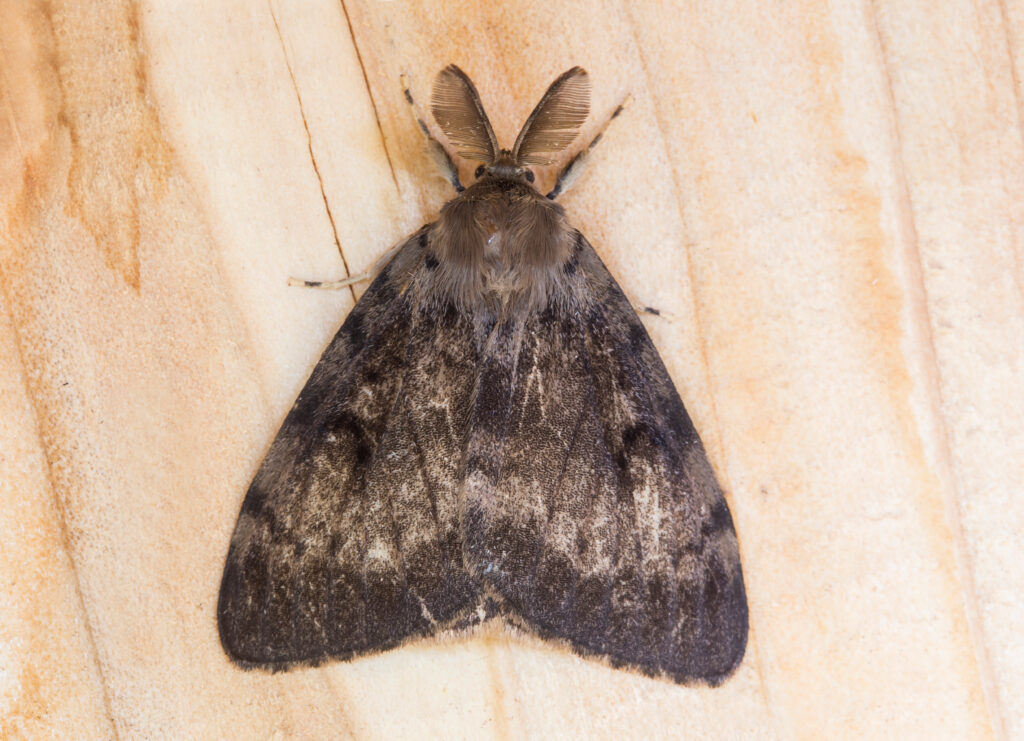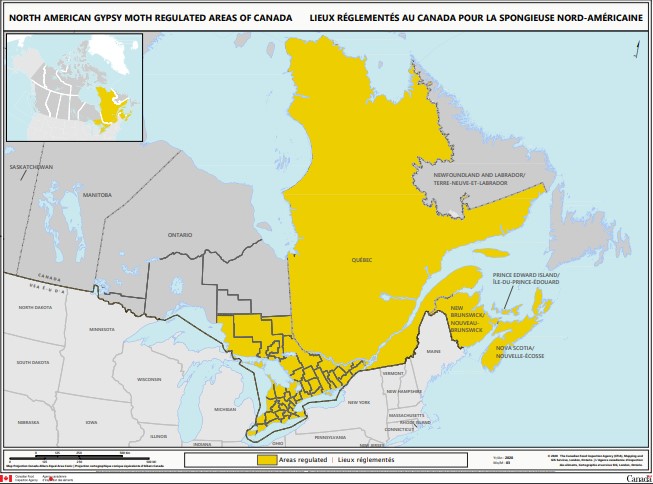
Gypsy Moths in North America
The damage caused by gypsy moths can have long-lasting impacts on local ecosystems and economies, making prevention and control efforts critical for the health and well-being of communities.
The Gypsy Moths’ invasion of North America dates back to the French coup d’etat staged by Napoléon Bonaparte‘s nephew, Louis-Napoléon Bonaparte. A member of this “self-coup” was 23-year-old Étienne Léopold Trouvelot. While it is unknown whether Trouvelot fled France or was exiled after the coup, by 1855, he had emigrated to Boston, Massachusetts. There he became interested in natural sciences, even going as far as to join the Boston Society of Natural History. When the American Civil War began in 1861, and cotton production began to plummet, Trouvelot saw a massive opening in the textile industry when the disease hit the traditional silk moth.
What Threat do Gypsy Moths Pose?
Gypsy Moths pose a substantial economic and ecological problem within North America. Due to the lack of natural predators in most North American ecosystems, gypsy moths feast on hardwood trees, leaves, and other plants unchecked at alarming rates. Over five hundred variations of plants can be easily stripped of their leaves and left for dead due to their inability to accomplish photosynthesis. As a result, tree defoliation along streams causes a rise in water temperatures. This can lead to fish and other aquatic life suffering at the hands of the gypsy moth. In addition to their effects on nature, gypsy moths also have negative effects on human life.
Gypsy Moths’ Effects on Urban Areas
In urban areas, gypsy moths have less of an impact than they do in the wild. Like in the wild, gypsy moths still annihilate trees which reduces shade along streets and in residential areas. Additionally, gypsy moths’ wings contain histamine. Histamines are responsible for allergen response within your body, which means when in contact with these histamines one can experience sneezing, itching, and tearing up, among other side effects associated with allergies.
Life Cycle of Gypsy Moths
The Gypsy Moth grows as a new generation each year. They grow in 4 developmental stages: egg, larva, pupa, and adult. After they hatch from their eggs (8-9 months), the larvae feast upon plant and tree leaves along with the other 500-1000 eggs they birth with. Unlike many other moths and butterflies, adult Gypsy Moths don’t feed. The only function of an adult Gypsy Moth is to reproduce.
Preventing the Spread of Gypsy Moths
There are a few reasons Gypsy Moths have not spread across the entire country. When gypsy moths migrate west, they do it gradually due to the female gypsy moth’s inability to fly. Additionally, when the gypsy moth population in an area begins to increase over the course of a decade, a fungal pathogen called entomophaga maimaiga dominates the large populations of gypsy moths by quickly killing larvae and creating clouds of spores with the ability to travel up to 40 miles away.
Even with these natural population and migration inhibitors, the United States Department of Agriculture (USDA) has devised a document to inspect shipments before crossing out of quarantined states and territories (this includes quarantined areas of Canada). This inspection can either be done by the shipper or by a professional. The checklist must accompany all shipments to ensure egg pods do not cross the protective territories.
Quarantined States

Statewide Quarantine
Partial Statewide Quarantine
Minnesota
Ohio
Quarantined Territories (Canada)
Eastern Canada was introduced to these moths in 1912 by a shipment of birch trees from Japan. The quarantine caused by the Gypsy Moth in Canada covers most of the area of these territories:
Gypsy Moth FAQ
Q. What is the problem with gypsy moths?
The problem with gypsy moths is their ability to lay large egg masses that hatch into destructive caterpillars. These caterpillars prefer hardwood trees and can cause significant damage to urban and backyard environments. It’s important to take necessary measures to control their population and prevent further damage.
Q. Are gypsy moths harmful to humans?
Yes, gypsy moths can be harmful to humans. During moderate or heavy outbreaks, exposure to young caterpillars can lead to skin rashes and irritations. Additionally, gypsy moth hairs can cause respiratory or eye irritation. It is important to take precautions if you live in an area with high gypsy moth populations.
Q. How many years do gypsy moth infestations last?
Gypsy moth infestations can last for 2 to 3 years in localized areas. These infestations go through population increase and decline cycles, with area-wide outbreaks lasting up to 10 years. Effective management practices, such as using biological control methods, can help reduce the impact of these infestations on forest ecosystems.
Why Choose FreightCenter?

25+ Years Of Experience
FreightCenter is proud to be a family-owned business with over 25 years of experience in the logistics industry. Since our founding, we've remained dedicated to providing exceptional service and building lasting relationships. Our family values and commitment to excellence have driven us to continually evolve and meet the changing needs of our clients, ensuring that we remain a trusted partner in freight shipping for decades.

Right Service At The Right Price
Depend on us to deliver the right service at the right price. Our extensive network of carriers allows us to tailor solutions to meet your specific needs while ensuring cost-efficiency. Whether you're shipping locally or internationally, our expert team works diligently to match you with the best service options, ensuring you receive top-quality support without compromising your budget. With FreightCenter, you get the perfect balance of reliability and value.

We Care About Our Customers
At FreightCenter, customer care is at the heart of everything we do. We're committed to providing personalized support and building lasting relationships with each client. Your satisfaction is our priority, and we're here to support you every step of the way.




